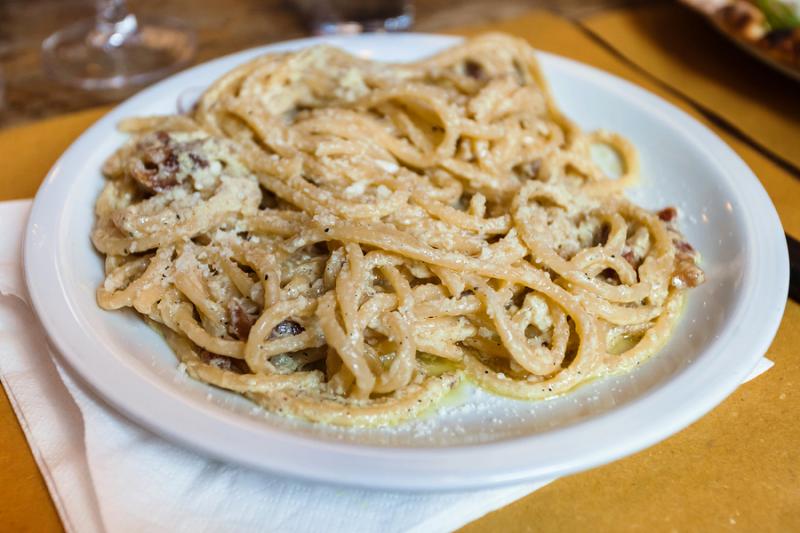Carbonara is an Italian pasta dish that originated in Rome. It is made with eggs, hard cheese like Pecorino Roman or Parmigiano-Reggiano, cured pork, and black pepper. But did you ever wonder how the dish came to be?
Carbonara did not exist prior to World War II and was most likely inspired by US military supplies of eggs and bacon in Italy during the time.
When was the Term “Carbonara” First Used?
Starting with historical cookbooks, the first example of mixing eggs and pasta is in Il Cuoco galante by Neapolitan Vincenzo Corrado, published in 1773, followed by fellow Neapolitan Ippolito Cavalcanti’s Theoretical-practical kitchen. In these two cases, the egg was only used as a thickener for broth-cooked pasta, fried dough balls, or pasta timbales, preparations that were not only far removed from carbonara but also from the very concept of pasta.
Francesco Palma, another Neapolitan, describes Maccheroni with cheese and eggs, in which he combines grated cheese, eggs, and lard in a plate of macaroni, as a decisive step forward. Cookbooks do not record the use of lard or guanciale (pork jowl) as a condiment for pasta until much later.
Let us recall Ada Boni’s 1949 recipe for Spaghetti al guanciale, published in The little talisman of happiness. Unfortunately, no eggs are present in her recipes, so they can only be considered the first examples of gricia, even if this moniker is imposed much later. And, while we’re on the subject of names, when was the first time you heard the term carbonara? Surprisingly, the name first appeared in a film. (Source:Gamberorosso International)
How Did the US Military Influence the Creation of this Dish?
During an unusual job interview with waitress Maria, played by Elsa Merlini, in the 1951 film Cameriera Bella Presence, the employer asks: Excuse me a moment, but do you know how to make spaghetti carbonara?” Even in the film’s fiction, the recipe was not widely known, as the waitress does not know it, though she can prepare spaghetti amatriciana.
In the same year, a second quote appears in Mario dell’Arco’s book Lunga vita di Trilussa or It’s difficult for our poet to address spaghetti alla carbonara or alla carettiera. But, returning to the recipes, the first carbonara recipe appears to have been published in the United States in 1952 in Patricia Bronté’s An extraordinary guide to what is cooking on Chicago’s Near North Side. The author reports a rather precise recipe in his review of the restaurant “Armando’s,” and you can’t go wrong: it’s the carbonara we’re all familiar with.
The first Italian recipe but not in the form we know it today, was published in the magazine La Cucina Italiana in August 1954. Spaghetti, egg, pancetta, gruyere, and garlic are the ingredients here. (Source:Gamberorosso International)
The La Cucina Italiana Recipe
The presence of garlic, particularly Gruyère, may raise more than one eyebrow. However, they are consistent with a recipe that was still relatively unknown domestically and in the early stages of definition at the time. Carbonara appears in an actual cookbook for the first time the following year, in The Lady in the Kitchen by Felix Dess, in a version more similar to today’s, with the addition of eggs, pepper, Parmigiano. Still, if you prefer spicy cheese, a good pecorino can replace it, and pancetta. (Source:Gamberorosso International)
